One of the most coveted, picturesque houseplants you can possess is the Philodendron ‘Pink Princess’. This is a houseplant that has been able to reach stardom status among growers and homeowners across the world due to its unique leaf variegation.
Here is everything you will need to know to grow and care for your Philodendron ‘Pink Princess’.
More...
Getting to Know the Philodendron ‘Pink Princess’

Philodendron erubescens or blushing philodendron, forms a part of the Araceae family being a species of flowering plant. They are native to Columbia so they grow best in tropical and balanced climates that don’t experience large polarities between seasons.
The Philodendron erubescens ‘Pink Princess’ can grow to be up to 3 metres high with a general width of 50 centimetres. The notorious heart-shaped leaves can reach up to 25 centimetres long with a width of around 12 centimetres. These plants are known to be fast-growing provided the conditions are right.
There are around 23 different varieties of Philodendron cultivars, where many possess different variegated and multi-coloured foliage.
However, the Philodendron ‘Pink Princess’ is one of the only varieties that showcase that splendid contrast of bubble-gum pink striations atop a dark green, almost black, leaf.
This captivating contrast of foliage is exactly why these houseplants are so sought-after.
How to Grow Philodendron ‘Pink Princess’

Source: ohiotropics.com
These plants are mostly used as indoor houseplants as they thrive in warm, humid environments with partial sun. However, they can also be grown outside in a shaded area of your garden.
For both scenarios, it is important to understand how much light they need, what levels of humidity are best, and what soil will be ideal for successful growth.
It is important to note that no two plants will look the same, meaning that each Philodendron plant will have its own unique variegation, patterns and mix of colours.
Growing Philodendron ‘Pink Princess’ from Seed
It is possible to grow Philodendron ‘Pink Princess’ from seed but not recommended. There is no guarantee that the leaves will turn velvety pink every time.
The change in leaf colour is a result of a mutation in the plant so when you grow using seeds, there is a chance that the plant may just regress to become a standard Philodendron plant with full green leaves.
However, should you be interested in giving it a go, here are the steps you can follow to grow the Philodendron ‘Pink Princess’ from seed:


Get Your Free Guide:
Master Growing Australian Natives eBook
A Must Have Complete Guide for Every Australian Garden
Get Your Free Guide:
Master Growing Australian Natives eBook
A Must Have Complete Guide for Every Australian Garden
- Fill your growing trays or pots with potting soil and evenly spread the soil. Don’t compact the soil too much.
- Pour a little water into each container and plant 2 to 3 seeds into each.
- Spray the top with some water to make the topsoil moist, but don’t overwater.
- If you are not using containers with domes to help improve humidity, then consider placing the tray or pots in a humid location away from direct sunlight. Humidity can help with the germination process.
- Wait two to three weeks to see if the seeds are sprouting.
- Move all healthy and sprouted seeds to their own pots and add some fertiliser to help them grow.
- Place the pots near locations with indirect sunlight and good humidity. Water and mist the plant to keep the soil moist but not wet.
Propagating Pink Philodendron
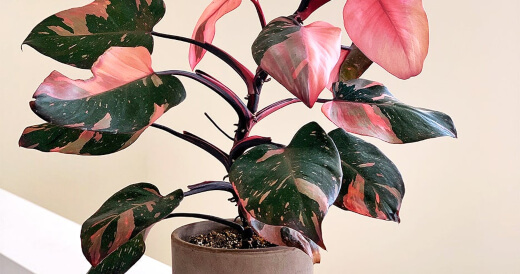
Source: domino.com
Propagating this plant can be easy and should be done during spring and the warmer months. Propagation can be done using cuttings or by division.
This is considered to be the best way to grow this plant due to the fact you can use parts of a healthy, successfully mutated ‘Pink Princess’.
Propagating Using Cuttings
- Using a sharp, clean blade, cut 15 centimetres of a healthy and actively growing stem from the donor plant.
- You can place the cut stem into a glass of fresh water to root in a warm, shaded location. You can alternatively place the cutting into a pot with potting mix and fertiliser.
- The plant should develop after around 4 to 5 weeks.
Propagation Using Division
- Remove the parent plant from its pot or bed and shake the roots loose so some of the soil falls off and you can see the root structure and stems.
- Using a sharp blade or garden shovel, cut a healthy part of the root and plant away taking care not to cause too much damage.
- Replant the divided plant into your desired location and place the parent plant back in its original location.
- Keep the divided plant moist and consider using some balanced 10-10-10 fertiliser to help stabilise the plant.
Planting the Philodendron ‘Pink Princess’

Source: indoorgardenook.com
Whether it’s indoors or outdoors, it is recommended to plant during spring. You now have your successfully germinated seed, your stem cutting that has started growing again, or your healthy divided plant so, it’s time to plant your ‘Pink Princess’.
The replanting process can be stressful for your plant so the quicker you can do it, the better the chance the plant will survive and thrive.
There are a few optimal growing conditions to consider that will ensure your plant thrives.
Soil Requirements
A nutrient-dense, well-draining, and airy soil mix is ideal for this plant. A mixture of 3 parts potting mix and 1 part perlite is recommended for container growing.
Planting soil rich in organic matter will help ensure your plant grows to be healthy and stout.
Sunlight
Being a tropical, ground covering plant, the Philodendron ‘Pink Princess’ thrives in warm, indirect sunlight. Placing it near a window inside where there is an abundance of filtered light or in a partially shaded area in the garden is recommended.
Full sun can be harmful to your plant and scorch the leaves so long-term exposure to full sun should be avoided as much as possible.
On the other hand, if the plant does not receive enough sun, it will struggle to produce chlorophyll for its food supply. So, a healthy balance is ideal.
Humidity & Temperature
Philodendron ‘Pink Princess’ love a humid environment. Ideally, a humidity level of 50% to 60% should be provided with temperatures ranging from 12 degrees to 35 degrees Celsius.
This is why most plant enthusiasts choose to grow this plant indoors as humidity and temperatures are naturally higher indoors which makes maintaining a healthy Philodendron ‘Pink Princess’ easier.
Planting Pink Philodendron Indoors
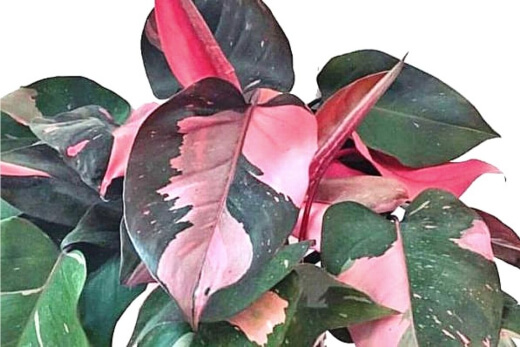
Source: absolutegardener.com
Now that you know where your Philodendron ‘Pink Princess’ will live and thrive in your home or garden, it’s time to plant. If you have decided to plant it indoors in a pot, be sure to use a well-draining container that is bigger than the current one, this will motivate the plant towards new growth and keep the soil drained sufficiently.
Here is what you need to do:
- Place a thin layer of small rocks or pebbles at the base of your new pot then fill with a small layer of your potting mix (see our review on the best potting mix available today).
Don’t compact the soil, try to leave it loose. - Gently extract from its current container, being sure to softly shake the old soil loose from the roots.
- Place the root ball into your new pot, being sure to try and keep the top of the roots and the top of the new container level. This will allow breathability in the new soil below the current root system which should encourage the plant to grow.
- Add the remaining soil and try not to over-compact it.
- Water the plant well for the first few days once it is planted.
Planting Philodendron ‘Pink Princess’ Outdoors
If you have decided to plant outdoors, here is what you will need to do:
- Dig a hole that is twice as big as your plants’ current container. The hole should be twice as wide and twice as deep.
- Loosen the soil at the bottom of your hole and if you want, you can add some slow-release granular fertiliser to help boost the nutrient content of the soil.
- Gently transfer your plant from its container to the prepared location in your garden bed.
- Pat the soil gently and make sure it is level with the surrounding soil. Try to ensure your soil is loose and not too compact to allow sufficient airflow and drainage.
- Water well for the first few days.
Philodendron ‘Pink Princess’ Care Tips
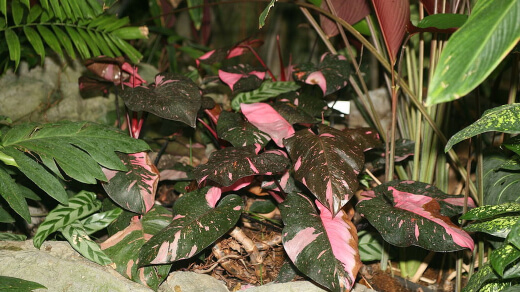
Source: kcrw.com
To ensure your plant stays healthy and happy, there are a few care tips you can follow. Once the plant has established itself in its new location, it will be pretty self-sufficient and shouldn’t require too much maintenance.
To ensure your plant keeps its bold, bright and beautiful foliage, here’s what you can do.
How to Water Philodendron ‘Pink Princess’
Keeping the soil consistently moist but not wet is recommended. Especially during the growing seasons and summer months. You will need to check when water is needed by using your finger or a soil moisture meter (see our product review and buying guide for soil moisture meters here).
The top few centimetres of soil should be dry before you water again. Consider using collected rainwater or distilled bottled water as tap water contains harmful chemicals like fluoride which can damage your plants’ root system and cause the leaves to lose their vibrance.
What Fertiliser to Use
You can add a balanced 10-10-10 fertiliser to your soil every 4 to 6 weeks during spring and in early autumn. Avoid fertilising in winter.
Your fertiliser shouldn’t have very high nitrogen content as this will affect the level of variegation in your Philodendron ‘Pink Princess’.
(See our complete fertiliser Australian users guide for more info.)
Pruning Blushing Philodendron
Light pruning is recommended for this plant. Prune dead leaves using sharpened secateurs to make clean cuts. Pruning can be done towards the end of winter to encourage new growth in the warmer months.
You can also wipe the healthy leaves with a damp cloth when pruning to get rid of dust and dirt that may be preventing the leaves from breathing properly.
Supporting Philodendron ‘Pink Princess’
As ‘Pink Princess’ grows and the leaves get bigger and heavier, the plant will require some structural support. Consider tying your plant to a post or rod to help it grow and support itself when needed.
Common Pink Philodendron Pests & Diseases
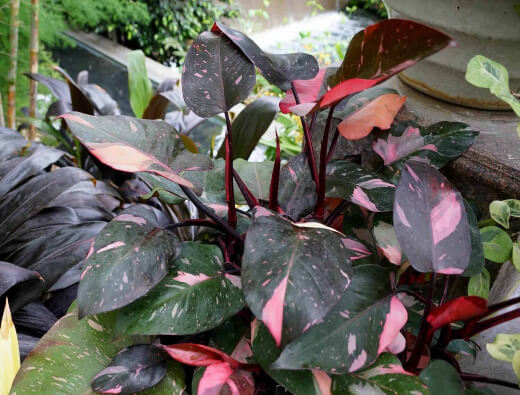
Source: hortzone.com
Philodendron ‘Pink Princess’ can suffer from common pests and moisture issues which can result in disease. Here are some of the common pest and disease problems.
Common pest infestations can include spider mites, aphids or fungus gnats. These can all be treated with horticultural oil or insecticidal soap.
Common diseases can include root rot and browning variegation and foliage. If you find your leaves are browning at the edges, this should indicate that your humidity levels are not high enough.
Consider misting your plant more often, using a pebble tray filled with water underneath your pot, or if possible, place your plant in your bathroom from time to time so it can soak in a little more moisture.
If your stem begins to turn brown and becomes mushy, this could mean your plant has root rot. This is caused by overwatering so immediately cut back on watering if you notice this.
In severe cases, repot your plant and monitor your watering more carefully. If your variegation begins to brown and become spotty, this means that the plant has been exposed to too much harsh light.
You will need to move your plant to an area with more shade and indirect light. You can gently cut away any burned parts of the leaves and increase moisture and humidity levels to encourage the plant towards healthy growth.
Philodendron ‘Pink Princess’ Frequently Asked Questions
Can a pink princess philodendron revert?
Unfortunately, yes. Should the plant become overrun with green leaves, it can revert to a standard, all-green philodendron in time. If you notice this, take a healthy cutting from a section of the plant that has pink variegation and replant that. The new plant should also then showcase more pink in its foliage.
What makes a pink princess philodendron?
The pink in the leaves is caused by a lack of chlorophyll. That is why a healthy combination of green and pink is best for these plants. The green sections of the leaves are what photosynthesize and feed the plant.
Why is my ‘Pink Princess’turning white?
The pink variegation can begin to turn white if the plant is located in an area with too much light or if the plant is not receiving sufficient nutrients. Move the plant to a more shaded location with more indirect light and consider fertilising more often.
Are you looking for more Philodendron varieties to grow? Be sure to see our growing guides on Philodendron xanadu and Philodendron hederaceum ‘Brasil’.
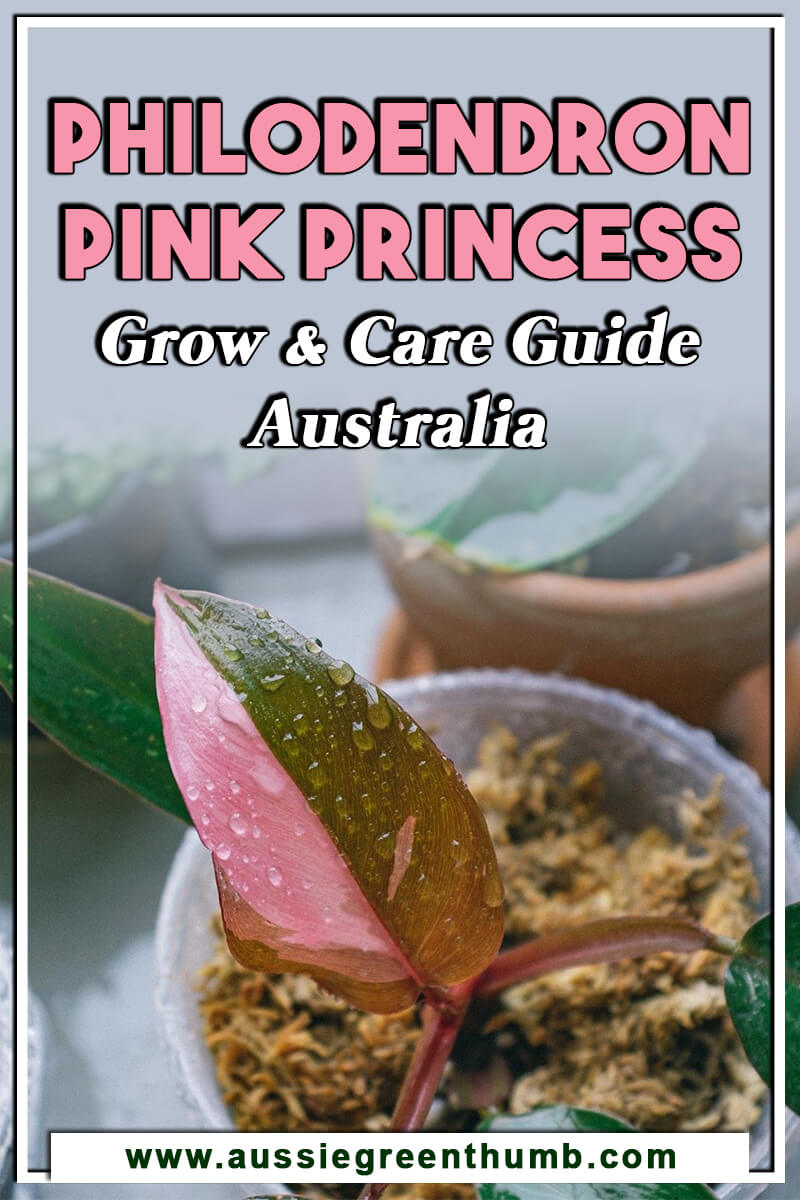
Add enchanting hues to your garden with the Philodendron ‘Pink Princess’
Globally celebrated and sought-after, the ‘Pink Princess’ will undoubtedly add unparalleled beauty and vivid tones of variegation to your home or garden. Being a rare and costly addition to your plant babies, it is essential to grow and care for yours correctly. Keep your plant in a well-lit, humid location and keep up with its moisture needs.
This should allow you to grow and nurture a healthy, thriving Philodendron ‘Pink Princess’.
Published on February 27, 2022 by Maisie Blevins
Last Updated on February 21, 2024




